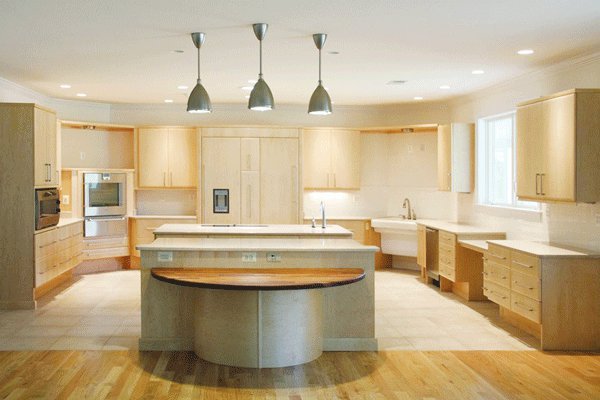Who You Calling Old?
Older Folks Spend More…
Elderly homeowners spend considerably more on home renovations than younger ones. According to the Hanley Wood Housing 360 Survey, those 65+ years of age spend on average $12,843 on additions to their homes. They’ll average $8,602 on major replacements and $7,127 on alterations.
Dealers are not the only group resistant to change. One major hurdle for a wider embrace of universal design comes from the very population who will shortly be needing its comfort.
No one knows better than Matt Thornhill, head of the Boomer Project, a marketing consultancy specializing in the boomer consumer, how resistant members of the silver tsunami are to talk of aging and the need to prepare for it.
“Boomers as old as 67 say, with a straight face, that 85 is old,” he said in a keynote address at the recent Universal Design Summit in St. Louis. “They don’t think they need universal design.”
Designers, builders, and product manufacturers have struggled for years to find ways to talk about universal design without mentioning aging. At the Universal Design Summit, the consensus was—regardless of the term used—to make the concept aspirational. If the design isn’t beautiful, if the products aren’t desirable, boomers won’t want it.
“We need to get away from the medical model,” says designer Mary Jo Peterson, founder of a design consultancy in Brookfield, Conn.
For instance, a ramp makes it possible for a wheelchair user to enter a home without assistance. But ramps are unsightly and scream “disabled.” However, a gently sloped paved pathway from the street to the entry door with a flush threshold accomplishes the same thing invisibly. Users of all ages and abilities, from a mom pushing a stroller to a teenage soccer player temporarily on crutches due to a sports injury to a wheelchair user, will find it useful.
But the small number of dealers who have heard the term, or its immediate (and still bandied-about) predecessor, aging-in-place design, think UD has more to do with grab bars and accessibility issues required by code under the Americans with Disabilities Act (ADA) of 1990 than a way of building that is appropriate for everyone.
Design for All Ages
A few, such as Cascade Lumber purchasing manager John Noonan, also fear more government mandates. Noonan regards UD as just using common sense.
“What we try to do when we design a home is design for all ages and abilities. I try to make sure we have a bath with a 5-foot turning radius and flat entries,” he says. “Even if the customer doesn’t, we bring it up as a talking point when working with our customers on new homes or additions, regardless of their age. This also applies to our kitchen and bath sales.”
“The entire building community is confused about what universal design is,” says Bill Owens, president of Owens Construction in Powell, Ohio. He believes so strongly in UD that he is involved in the creation of the Better Living Design Institute (BLD), along with sponsor AARP, to promote the concept of UD under the moniker of “better living design” (another example of a movement in search of a name).
Eventually, the institute hopes to offer a BLD Certification for builders, remodelers, and designers, which will assure homeowners that their homes have been built to the highest standards of universal—or better living—design.
Builders who are doing UD construction and remodels are still the exception rather than the rule, but they say they could sure use dealers’ help. “Dealers could be the white knights in this scenario by providing educational materials and information to builders and retail customers, and holding Saturday classes in their showrooms,” Owens says.
Anthony Palladino, residential designer for Golden Rule Builders, agrees, saying, “It would add a lot of value if yards could give me information and knew what I was trying to achieve. I would pay more to go to a yard who helped me.”
The Catlett, Va.-based builder specializes in green and energy-efficient design and has done a number of projects using UD principles, including a home for client Ron Knecht in Nokesville, Va., that won the 2012 GreenBuilder Best Aging-in-Place Home Award.
Palladino took one younger client, his pregnant wife, and their 2-year-old daughter to tour Knecht’s house, and “they loved it. They loved the walk-in showers and wide walkways and no steps from the garage [into the house] and the package shelves at the front and side doors. I see large families really being able to use this,” he says.
Jeffrey Hoag, a sales rep for ProBuild in St. Cloud, Minn., sees universal design coming into play in a greater percentage of his designs for customers. “Younger clients are easy to convert to the idea of universal design, as they see the resale potential,” he says.
“Universal design is where building is going,” says Bryce Jacobs, who teaches National Association of the Remodeling Industry’s UD certification classes.
Jacobs, who is vice president of Dave Fox Design Build in Columbus, Ohio, says, “It would be hugely beneficial to us and to them [dealers] to be familiar with universal design. Each of us in the market is looking for a way to differentiate ourselves. Remodelers go with what they know, so if vendors and dealers can give them a reason to do things differently and supply what they need, it would be very helpful.”
Related Articles:
Convenience and Cool Sell
Universal Design in Practice



